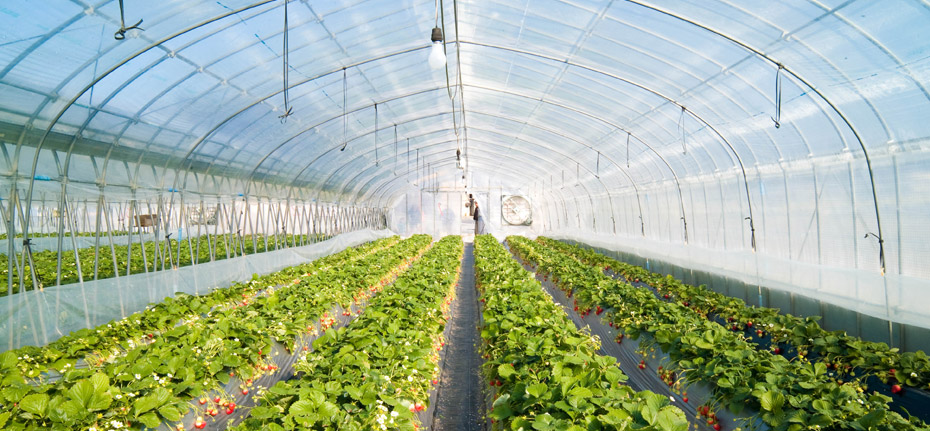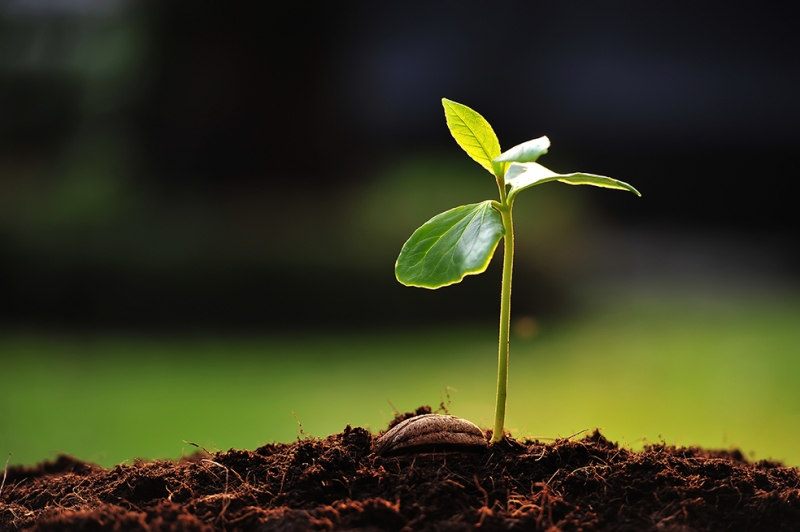Treatment Systems for Greenhouses
SOILLESS AGRICULTURE (AQUATIC AGRICULTURE)
Every living thing needs minerals necessary for its growth. The type and amount of these minerals varies according to each living thing. In addition, existing environmental conditions also affect this development. This rule also applies to plants. That is why people have developed the greenhouse method to control adverse environmental conditions and obtain crops at any time of the year. In field farming, we can give the plant its wishes through soil or irrigation. But we can't control its environmental conditions.
The advantage of soilless agriculture, in other words water agriculture, is that the growth of the plant is also under control according to the greenhouse system in the soil. That is, to eliminate the braking system of the plant. The difference from the production in the field is to purify the plants from other conditions.
In soilless agriculture; It is to give the minerals that the plant wants to the plant through water. The only important point is to make it in the material that will keep the plant afloat and allow its roots to touch the water. Soilless farming is a frequently preferred method in greenhouses.
SOILED AGRICULTURE
Soiled agriculture; is the cultivation of plants in proper conditions by contact with the soil.
Greenhouses are building elements covered with light-transmitting materials such as glass, plastic, fiberglass, whose environmental conditions can be controlled or regulated in order to provide suitable conditions for the growth of plants.
In places where the temperate climate prevails, the cultivation of vegetables and fruits is usually carried out under a glass cover for vegetables and a plastic cover for fruits. The entire professional greenhouse is galvanized, the construction of which is mounted with screws, static calculations are designed depending on the geographical location and the tonnage of the product to be grown in it.
Artificial conditions provided in greenhouses:
• Heating
• Ventilation
• Irrigation and Fertilization
• Spraying is carried out with the use of technology.

GREENHOUSE AIR CONDITIONING CONDITIONS
Heating
Although providing the heat desired by the plants is realized by taking the plants under cover, this may not be enough. In such cases, heating systems are put inside the greenhouse. These systems keep the heat in the greenhouse constant within the desired range.
Aeration
Humidity in the greenhouse is provided by ventilation systems. With aeration, they also ensure the fertilization of plants.
Irrigation and Fertilization
Determining the watering times and appropriate irrigation forms of the plants taken into the greenhouse is carried out with fertilizers and irrigation systems that the plants need for their healthy development when necessary.
Spraying
An effective fight against microbes that damage plants in the greenhouse is carried out with spraying systems installed in the greenhouse. Spraying into the soil is carried out with irrigation systems when appropriate. If spraying will be carried out on the above-ground parts of the plants, this is carried out with a separate spraying system.
Greenhouse Fogging Systems
Fogging System is the system used to cool the environment in a short time and to provide the moisture needed by the plant in the greenhouse. One of the systems established in order to provide the moisture needed by the plant in the greenhouses and to reduce the greenhouse indoor temperature is the fogging method. The method of fogging is a technique between humidification of the air and soil irrigation.
Fogging System Working Principles
Fogging System consists of different elements.
• High pressure pump (70-150 bar 8-35 l/min. capacity)
• Ansynchronous extrome
• Pressure regulator
• Mechanically cleaning the water filter (5-20 micron) prevents clogging
• Spray nozzle
• Control panel
Small drops of water evaporate to create cooling. The surrounding heat is absorbed. Water droplets thin than 10 microns are sprinkled through the spray nozzles, increasing humidity without the environment and plant getting wet.
Fogging System Usage Areas
Air conditioning
Spraying
Ambient cooling
Watering
Humidification
In different environments for sterilization purposes
Water Required to Use for Fogging System
When designing irrigation systems in greenhouses, care should be taken to choose water and energy-saving systems. It should be understood from water saving to minimize the amount of water flowing into the surface flow, leaking deep and evaporating, and from energy saving, reducing the evaporation of the irrigation water given and reducing the latent heat lost from the cover surface. In modern greenhouses established in recent years, drip irrigation systems with spaghetti drippers are used, which irrigate a single plant. In greenhouses with a medium technology, drip irrigation systems are used, which irrigate the rollers in direct planting in the ground.
It is absolutely necessary to analyze the water to be used in greenhouse irrigation. As a result of the analyzes to be made, it should be decided to use the existing resource in irrigation.
Water parameters to be considered in the greenhouse fogging system;
*TDS
*Conductivity
*pH
*HARDNESS
After the analysis, appropriate treatment systems should be selected in line with the parameters mentioned above.
If we give an example of these systems;
*Chlorine Dosing Systems (Prevention of Bacterial Formation)
* Filtration Systems (Taste, Odor, Particulate Matter, Turbidity, Color Removal)
*Softening Systems (Hardness Removal)
* Reverse Osmosis Systems (Chemical Meter Removal-Providing the Desired Conductivity)
IRRIGATION WATER CRITERIA
* The water to be used in irrigation should be ventilated.
* Watering water should not be cold.
* There should be no mineral substances harmful to plants in irrigation water.
* Irrigation water should not be salty and soda.
| Quality Criteria | Class I Water (Very Good) | Class II Water (Good) | Class III Water (Usable) | Class IV Water (Should be used with caution) | Class V Water (Pest not suitable) |
| EC 25×106 | 0 – 250 | 250 – 750 | 750 – 2000 | 2000 – 3000 | > 3000 |
| Variable Sodium Percentage (%Na) | < 20 | 20 – 40 | 40 – 60 | 60 – 80 | > 80 |
| Sodium Adsorption Rate (SAR) | < 10 | 10 – 18 | 18 – 26 | > 26 | |
| Sodium carbonate residue (RSC) meq/l
mg/l |
> 1,25
< 66 |
1,25 – 2,5
66 – 133 |
> 2,5
> 133 |
||
| Chloride (Cl), meq/l
mg/l |
0 – 4
0 – 142 |
4 – 7
142 – 249 |
7 – 12
249 – 426 |
12 – 20
426 – 710 |
> 20
>710 |
| Sulfate (SO4=) meq/l
mg/l |
0 – 4
0 – 192 |
4 – 7
192 – 336 |
7 – 12
336 – 575 |
12 – 20
575 – 960 |
> 20
> 960 |
| Total Salt Concentration (mg/l) | 0 – 175 | 175 – 575 | 575 – 1400 | 1400 – 2100 | > 2100 |
| Boron Concentration (mg/l) | 0 – 0,5 | 0,5 – 1,12 | 1,12 – 2,0 | > 2,0 | – |
| Irrigation Water Class* | C1S1 | C1S2,
C2S2, C2S1 |
C1S3, C2S3,
C3S3, C3S2, C3S1 |
C1S4, C2S4, C3S4,
C4S4, C4S3, C4S2, C4S1 |
– |
| NO3 or NH4+mg/l | 0 – 5 | 5 – 10 | 10 – 30 | 30 – 50 | > 50 |
| Fecal Coliform ** 1/100 ml | 0 – 2 | 2 – 20 | 20 – 100 | 100 – 1000 | > 1000 |
| BOI5 (mg/l) | 0 – 25 | 25 – 50 | 50 – 100 | 100 – 200 | > 200 |
| Suspended solids (mg/l) | 20 | 30 | 45 | 60 | > 100 |
| Ph | 6,5 – 8,5 | 6,5 – 8,5 | 6,5 – 8,5 | 6,5 – 9 | < 6 veya > 9 |
| Temperature | 30 | 30 | 35 | 40 | > 40 |
Classification of irrigation waters according to the resistance of plants to boron mineral
Boron Concentration in Irrigation Water (mg/1)
| Irrigation Water
Class |
Sensitive
Plants 1 (mg/l) |
Moderate 2
Hardy Plants |
Resistant 3 Plants |
| I | Less than 0.33 | Less than 0.67 | Less than 1.0 |
| II | 0,33 – 0,67 | 0,67 – 1,33 | 1,00 – 2,00 |
| III | 0,67 – 1,00 | 1,33 – 2,00 | 2,00 – 3,00 |
| IV | 100 – 1,25 | 2,00 – 2,50 | 3,00 – 3,75 |
| V | More than 1.25 | More than 2.50 | More than 3.75 |
1 : Example ; Walnuts, Lemons, Figs, Apples, Grapes and Beans
2 : Example : Barley, Wheat. Corn, Oats, Olives and Cotton
3 : Example : Sugar Beet, Alfalfa, Pods, Onions, Lettuce and Carrots
Maximum Permissible Concentrations of Heavy Metals and Toxic Elements in Irrigation Water
| Elements | Maximum total quantities that can be given per unit area, kg/ha | Continuous irrigation on all kinds of ground is also the limit values mg/l | When irrigation is carried out for less than 24 years on clay soils with a pH value between 6.0 and 8.5, mg/l |
| Aluminium (Al) | 4600 | 5,0 | 20,0 |
| Arsenic (A.S.) | 90 | 0,1 | 2,0 |
| Beryllium (Be) | 90 | 0,1 | 0,5 |
| Boron (B) | 680 | – | 2,0 |
| Kadminium (Cd) | 9 | 0,01 | 0,05 |
| Chromium (Cr) | 90 | 0,1 | 1,0 |
| Cobalt (Co) | 45 | 0,05 | 5,0 |
| Copper (Cu) | 190 | 0,2 | 5,0 |
| Fluoride (F) | 920 | 1,0 | 15,0 |
| Iron (Fe) | 4600 | 5,0 | 20,0 |
| Lead (Pb) | 4600 | 5,0 | 10,0 |
| Lithium (Li) | – | 2,5 | 2,5 |
| Manganese (Mn) | 920 | 0,2 | 2,0 |
| Molybdenum (Mo) | 9 | 0,01 | 0,05 |
| Nickel (Ni) | 920 | 0,2 | 2,0 |
| Selenium (Se) | 16 | 0,02 | 0,02 |
| Vanadium (V) | – | 0,1 | 1,0 |
| Zinc (Zn) | 1840 | 2,0 | 10,0 |
1 For irrigated citrus fruits, it is 0.075 mg/1.
2 It is the permissible concentration only in acidic clay soils with a high iron content.
Taking into account the parameters in the tables mentioned above, the quality of the water to be used as irrigation water should be ensured by the use of treatment systems.
In line with your Kuşadası Water Treatment needs, we provide the design, sale and after-sales services of greenhouse treatment and irrigation systems with our expert staff. We are here for your process solutions.
